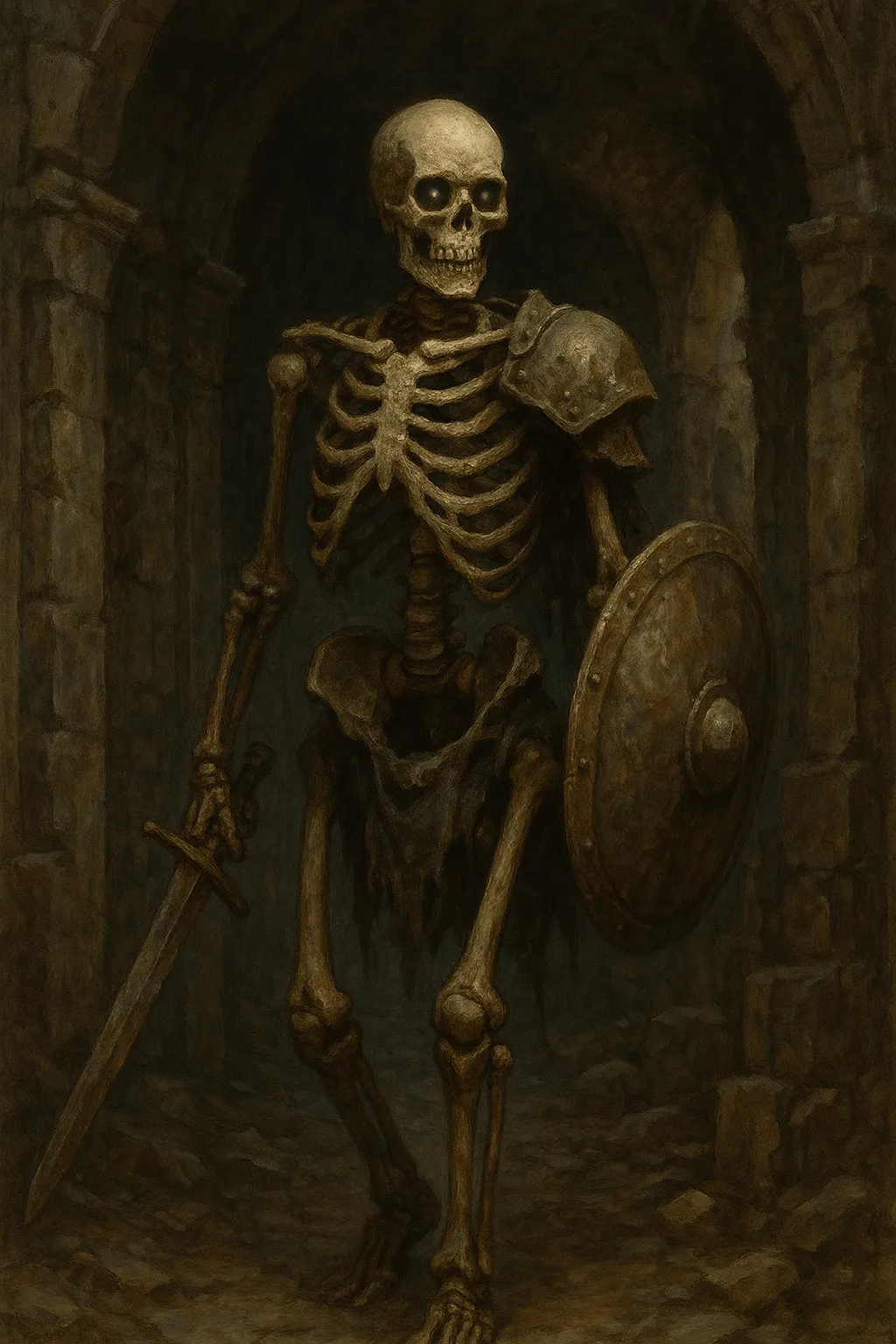
Still following orders. Still no skin in the game.
Among the many forms of undeath catalogued by scholars of the arcane, none are as ubiquitous—or as underestimated—as the reanimated skeleton. Known in various tongues as bonewalkers, marrowshades, or simply “the dry,” these skeletal constructs serve as the most elementary manifestation of necromantic animation. Yet despite their simplicity, they raise profound questions about memory, magic, and the fragile boundary between death and servitude.
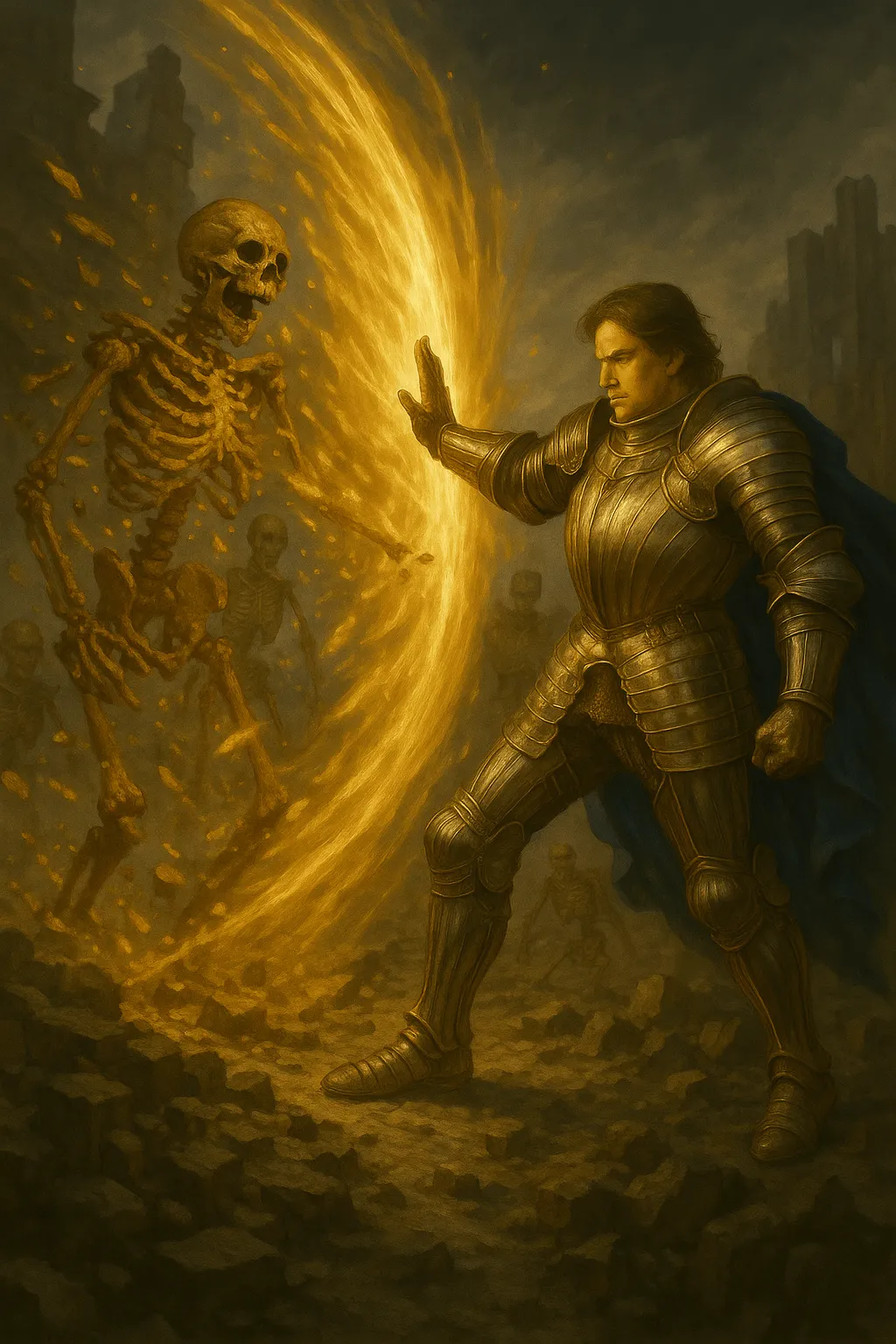 A reanimated skeleton is, in essence, a humanoid (or occasionally bestial) skeleton returned to a semblance of motion through magical means. Unlike more complex undead such as vampires, reanimated skeletons possess no soul, identity, or volition. They are constructs, animated not by the return of a spirit but by the binding of raw magical force—typically through necromantic rites, sigils, or the latent energies of cursed grounds.
A reanimated skeleton is, in essence, a humanoid (or occasionally bestial) skeleton returned to a semblance of motion through magical means. Unlike more complex undead such as vampires, reanimated skeletons possess no soul, identity, or volition. They are constructs, animated not by the return of a spirit but by the binding of raw magical force—typically through necromantic rites, sigils, or the latent energies of cursed grounds.
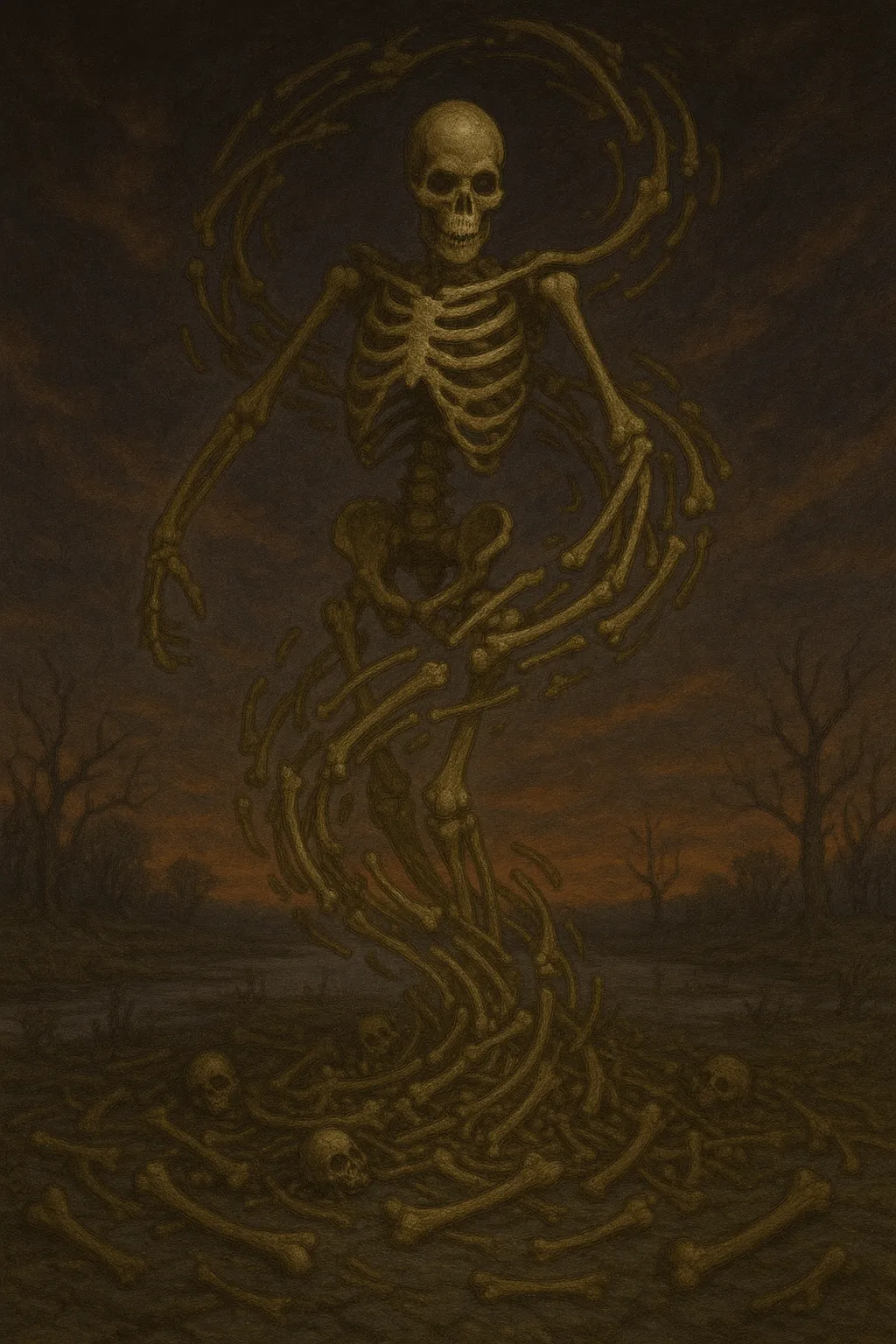 Their creation is often described in textbooks as "entry-level necromancy," though the phrase belies the delicate balance required. Bone, for all its strength, is brittle; magical binding must account for joint tension, skeletal memory, and ambient decay. Too little power and the construct collapses; too much and the skeleton risks shattering under its own violent convulsions. Skilled necromancers employ bone-binding matrices, joint-sealing glyphs, and harmonic pulse triggers—spells that simulate the cadence of life without mimicking its essence.
Their creation is often described in textbooks as "entry-level necromancy," though the phrase belies the delicate balance required. Bone, for all its strength, is brittle; magical binding must account for joint tension, skeletal memory, and ambient decay. Too little power and the construct collapses; too much and the skeleton risks shattering under its own violent convulsions. Skilled necromancers employ bone-binding matrices, joint-sealing glyphs, and harmonic pulse triggers—spells that simulate the cadence of life without mimicking its essence.
Most reanimated skeletons exhibit only the barest functionality. They can walk, wield weapons, follow orders, and patrol territories. Their vision is not visual in the traditional sense but arcane: an awareness of movement, temperature, and magical signatures. In some variants, remnants of optic tissue or scrying gems are fused into their skulls, enhancing their ability to track targets in darkness or through illusions. They do not feel pain, cannot be reasoned with, and—being devoid of fear—will fight until physically destroyed or magically dispelled.
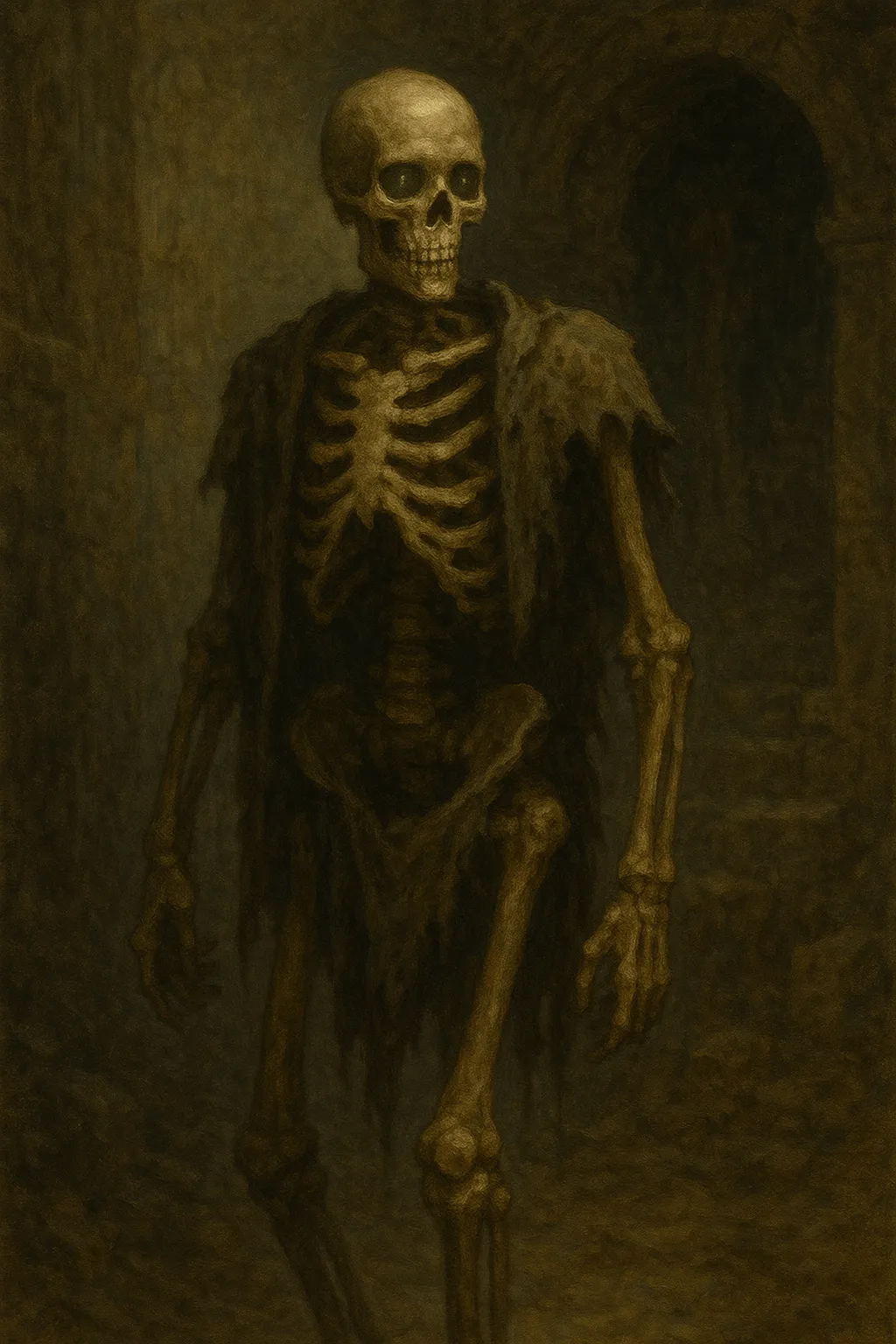 They are often raised from ancient graves, battlefields, or mass burial sites, where bone density and ambient necrotic energy are sufficient to support large-scale animation. Some skeletons are centuries old, drawn from ossuaries or crypts where the dead were ritually prepared. Others are recent casualties, their flesh scoured clean by fire, vermin, or time before animation. A skilled necromancer can raise dozens at once with the right focus, making skeletons ideal foot soldiers for magical warbands or death cults with limited resources.
They are often raised from ancient graves, battlefields, or mass burial sites, where bone density and ambient necrotic energy are sufficient to support large-scale animation. Some skeletons are centuries old, drawn from ossuaries or crypts where the dead were ritually prepared. Others are recent casualties, their flesh scoured clean by fire, vermin, or time before animation. A skilled necromancer can raise dozens at once with the right focus, making skeletons ideal foot soldiers for magical warbands or death cults with limited resources.
Despite their utilitarian role, skeletons often carry symbolic weight. In many cultures, the appearance of bonewalkers is a sign of magical defilement—a signal that the natural cycle of death and decay has been ruptured. Some faiths consider the reanimation of bones a sacrilege against the ancestors; others take a more pragmatic view, seeing skeletons as tools, no different from golems or constructs. In certain societies, condemned criminals may be sentenced to posthumous servitude, their bones harvested and bound as a form of punishment beyond the grave.
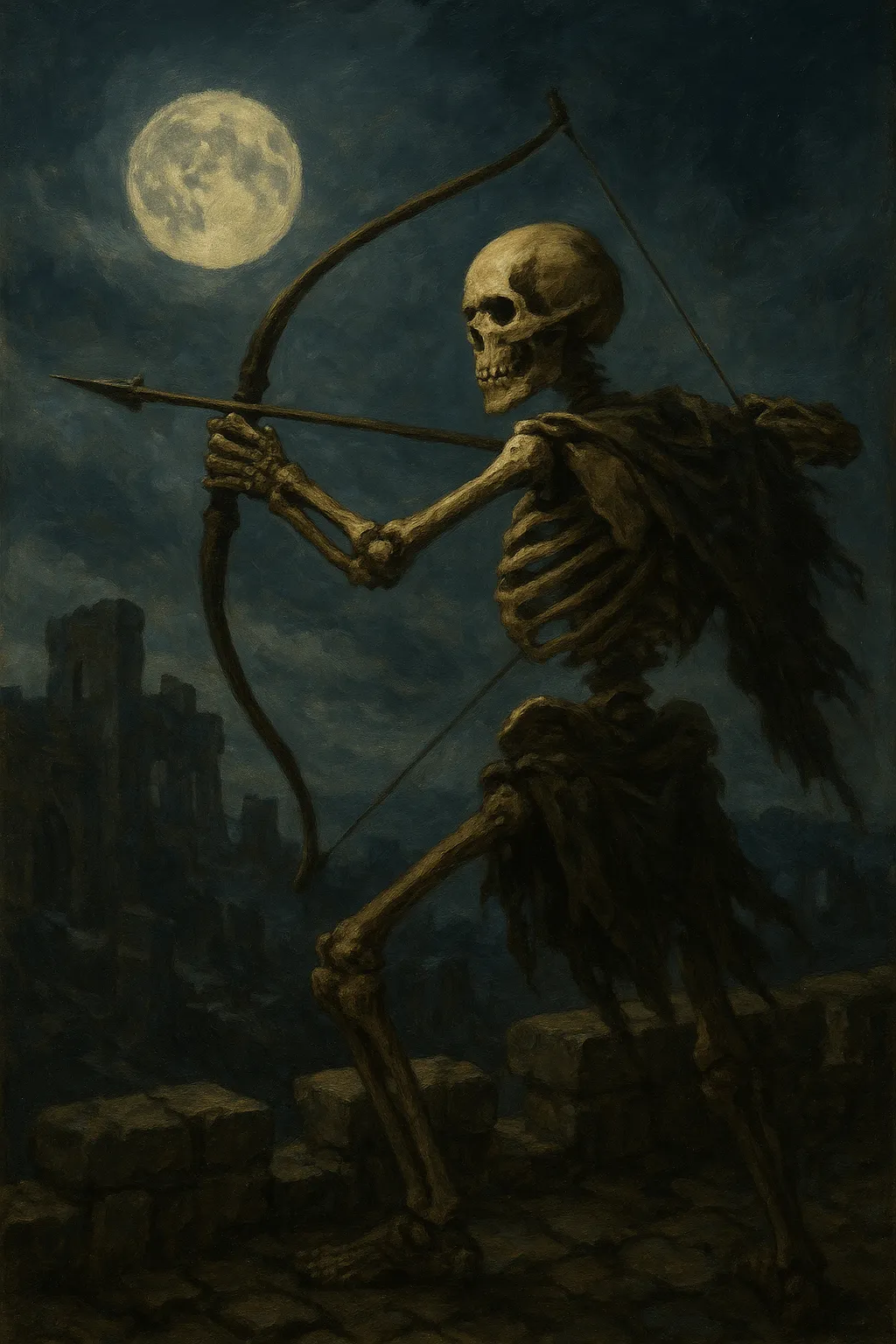 Reanimated skeletons are not intelligent, but that does not mean they are unpredictable. They operate through magical instruction, often in the form of embedded commands or necro-scripted runes. A skeleton may be told to guard a doorway, pursue trespassers, or fight until broken. More sophisticated necromancers can imbue their creations with conditional responses—"if attacked, retreat and signal"—but such logic trees are limited by the medium of bone and spellcraft. One can think of them less as soldiers and more as semi-programmed weapons.
Reanimated skeletons are not intelligent, but that does not mean they are unpredictable. They operate through magical instruction, often in the form of embedded commands or necro-scripted runes. A skeleton may be told to guard a doorway, pursue trespassers, or fight until broken. More sophisticated necromancers can imbue their creations with conditional responses—"if attacked, retreat and signal"—but such logic trees are limited by the medium of bone and spellcraft. One can think of them less as soldiers and more as semi-programmed weapons.
Over time, skeletons degrade. Joints loosen. Magical bindings fray. Insects and moss take root in the hollows of their frames. Many collapse mid-task, littering forgotten corridors with the remains of half-finished patrols. Others become erratic, executing broken commands long after their creators have vanished. In such cases, local villagers may speak of “wandering bones” or “the restless marrow,” blaming ruined fields or dead livestock on half-aware skeletons stumbling through the night.
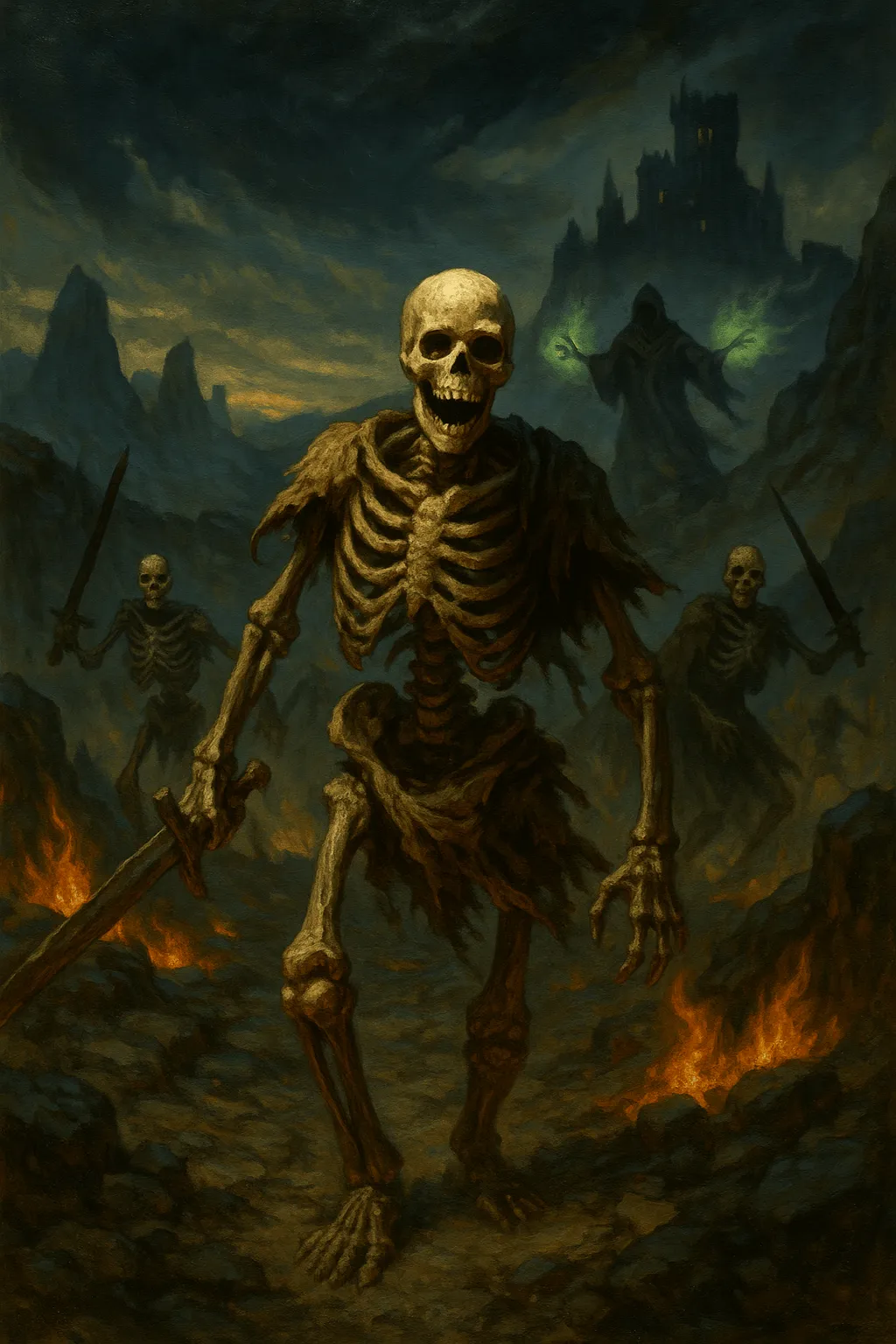 There are exceptions. Rare cases exist of reanimated skeletons that appear to retain fragments of memory—a former gesture, a familiar path, a repeated word. These occurrences are hotly debated. Some theorize that powerful emotional imprints can anchor psychic residue to bone, creating echoes rather than true sentience. Others argue that such anomalies are the result of overlapping magical patterns, or contamination from ambient spirits. Whatever the cause, these skeletons blur the line between construct and revenant, and are typically destroyed or contained as a precaution.
There are exceptions. Rare cases exist of reanimated skeletons that appear to retain fragments of memory—a former gesture, a familiar path, a repeated word. These occurrences are hotly debated. Some theorize that powerful emotional imprints can anchor psychic residue to bone, creating echoes rather than true sentience. Others argue that such anomalies are the result of overlapping magical patterns, or contamination from ambient spirits. Whatever the cause, these skeletons blur the line between construct and revenant, and are typically destroyed or contained as a precaution.
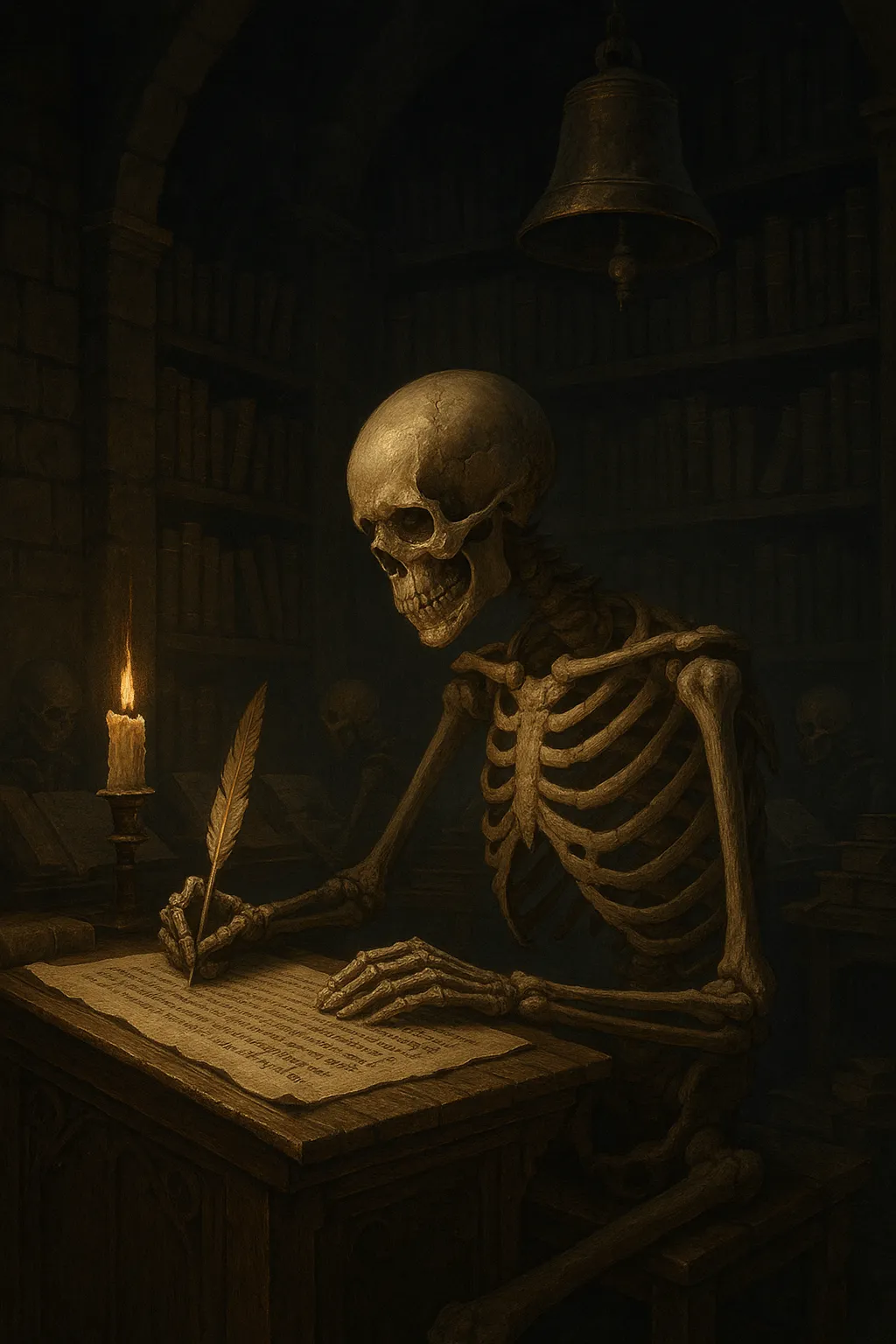 Not all reanimations are hostile. In isolated cases, skeletons have been bound as laborers, scribes, or even musicians—so long as the task requires little creativity. In one infamous monastery, a collection of animated bones was tasked with endlessly transcribing the same scripture, their quills scratching away long after the last monk had died. Even today, travelers speak of skeletal scribes who continue their work, unaware that centuries have passed since the bell last rang.
Not all reanimations are hostile. In isolated cases, skeletons have been bound as laborers, scribes, or even musicians—so long as the task requires little creativity. In one infamous monastery, a collection of animated bones was tasked with endlessly transcribing the same scripture, their quills scratching away long after the last monk had died. Even today, travelers speak of skeletal scribes who continue their work, unaware that centuries have passed since the bell last rang.
Despite their lack of autonomy, skeletons are not to be dismissed. A single reanimated warrior is often sufficient to hold a corridor or exhaust an untrained opponent. Their immunity to most conventional fears and injuries makes them effective sentries, and their silence—save for the occasional clatter of bone—makes them unnervingly efficient. Yet their true strength lies in numbers. A phalanx of skeletons, armed and directed by a competent necromancer, can break the morale of even hardened soldiers.
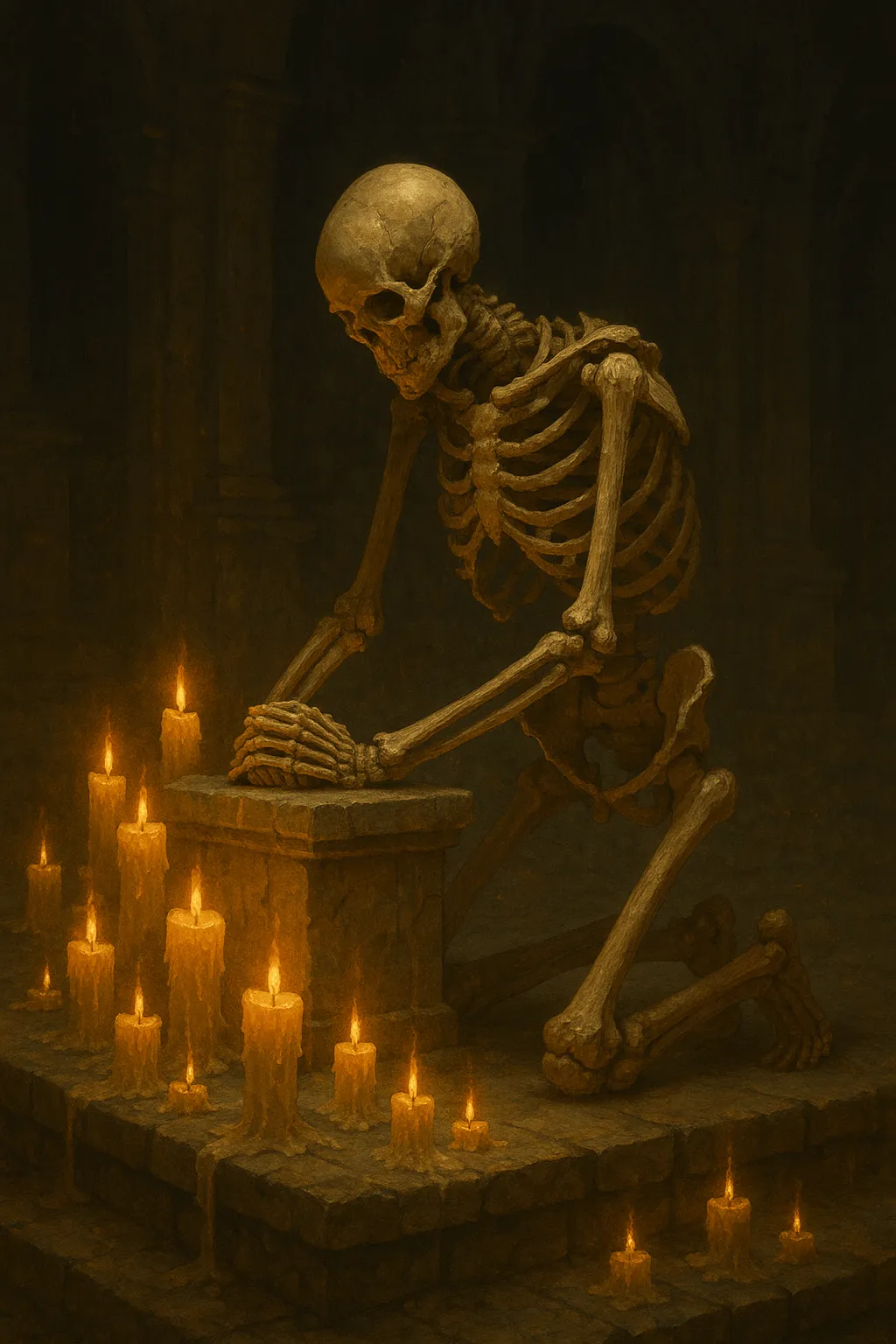 As magical understanding has grown, so too have methods for dealing with bonewalkers. Dispel wards, blessed salts, and fracture-focused weaponry are all commonly employed. Most trained adventurers know to aim for joints, not skulls; to sever the spinal arch, not to cleave ribcages. Others carry enchantments that disrupt necromantic pulses, causing skeletons to collapse like dropped marionettes.
As magical understanding has grown, so too have methods for dealing with bonewalkers. Dispel wards, blessed salts, and fracture-focused weaponry are all commonly employed. Most trained adventurers know to aim for joints, not skulls; to sever the spinal arch, not to cleave ribcages. Others carry enchantments that disrupt necromantic pulses, causing skeletons to collapse like dropped marionettes.
In the end, the reanimated skeleton serves as a grim reminder: that magic, when unbound by life, will seek out what remains. That the bones beneath our skin may one day rise—not in defiance, nor in will, but in silent, obedient service to the art that outlived us.
The following magical heirlooms are fictional and lore-based in nature. Each one is an affiliate link to a real-world item on Amazon that we've hand-selected to complement this artifact's lore.
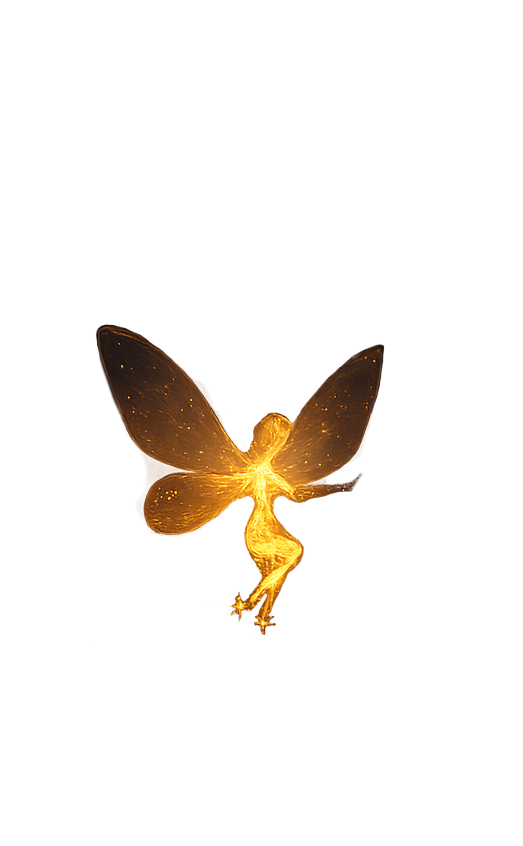
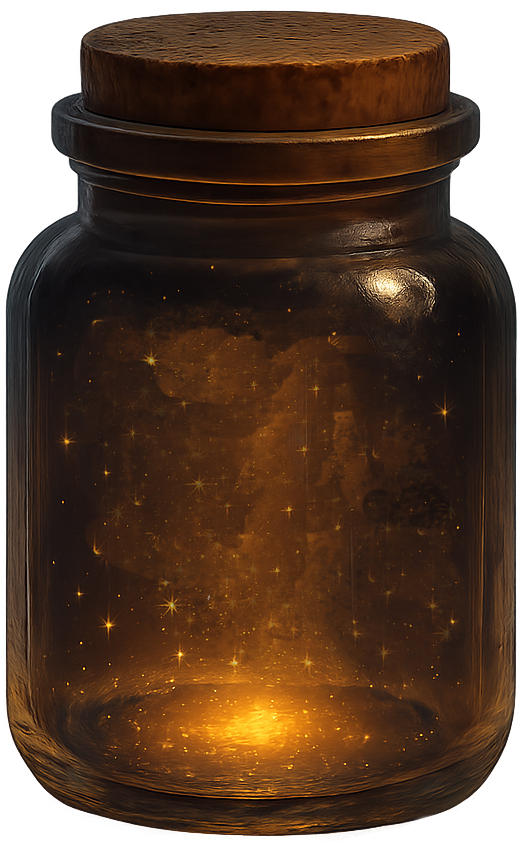
If you click a link and buy an item, we may earn a commission.It costs you nothing extra, but can help keep this little corner of the internet glowing.
What does this mean?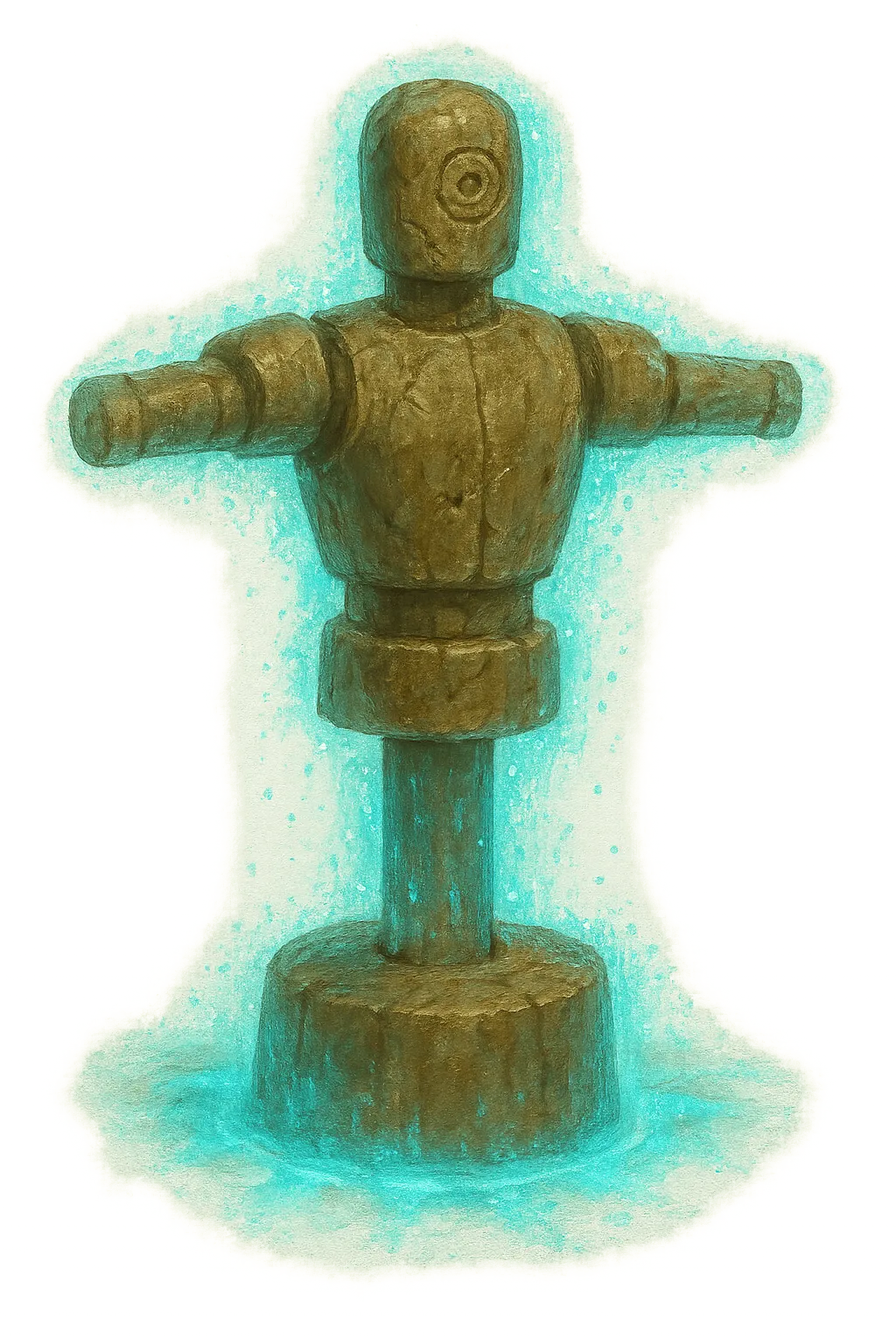
Even those with the fastest cat-like reflexes are unable to land a single blow.
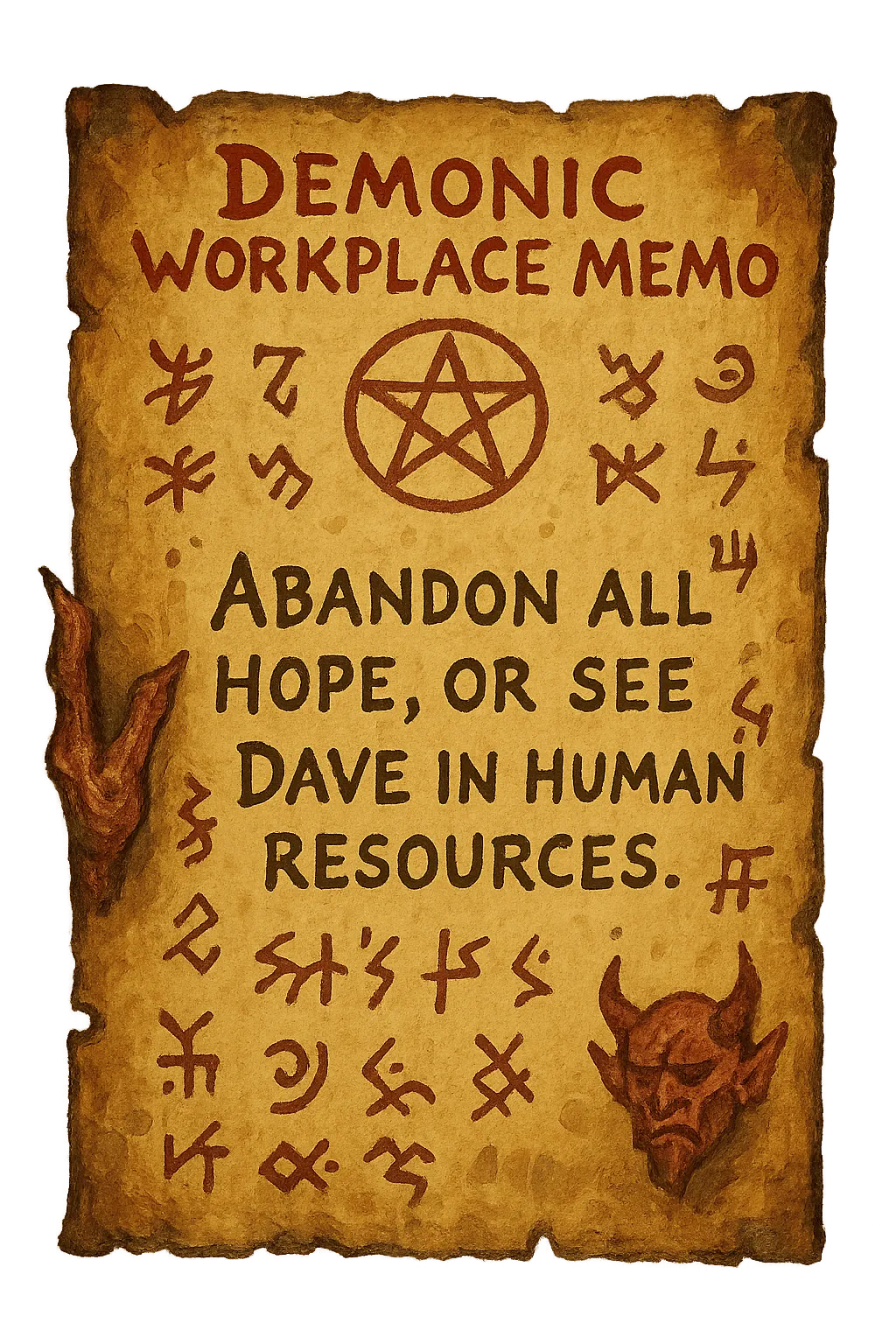
Legend claims it appeared shortly after the promotion of Dave, a lesser imp with an overzealous fondness for memos and motivational rituals.

Now anyone can be a daywalker with the our new vampiric camping gear!
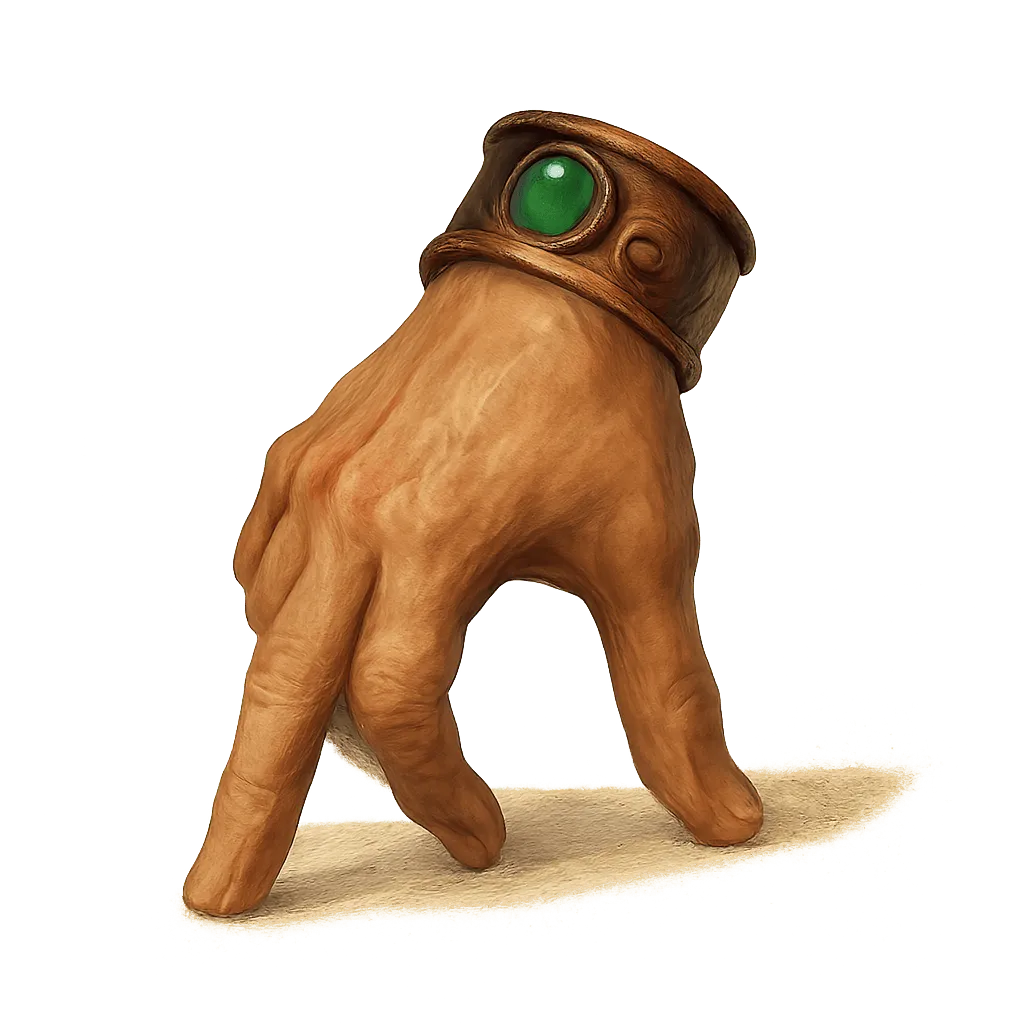
Summoned from the Sock Dimension, it’s great at holding snacks, bad at boundaries, and constantly trying to pat your head encouragingly.






